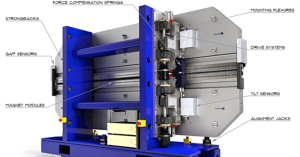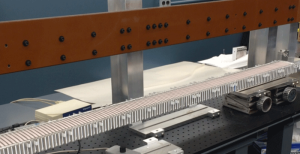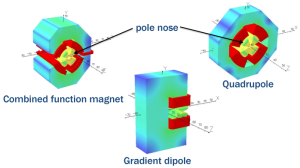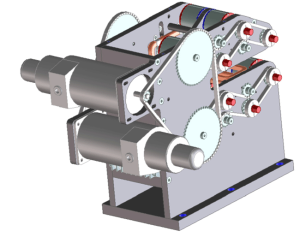BCMT is engaged in a variety of magnet design and fabrication projects, as well as R&D for futuristic magnetics capabilities beyond the current state of the art, that benefit storage-ring synchrotron light sources such as Berkeley Lab’s Advanced Light Source (ALS) and the proposed ALS Upgrade (ALS-U), as well as free-electron lasers like the LCLS-II project at SLAC. These systems include both undulators and lattice magnets.
Magnetics systems for these facilities span the range from electromagnets and hybrid (combination systems incorporating permanent magnets and iron-core electromagnets) magnets, to pure permanent-magnet systems, to superconducing magnets using materials at or beyond the state of the art such as niobium-three-tin (Nb3Sn) and high-Tc materials. Magnet tuning technologies (pulse-wire and small-bore) are also important contributions we can make.
Undulators for Light Sources and FELs
Berkeley Lab has a long tradition of excellence in undulator design and related areas of magnetic measurement, going back to the mid 1980s and the design and construction effort that culminated in the Advanced Light Source (and its many subsequent enhancements).
 Among our recent achievements has been a novel magnetics design that enables unsurpassed integral and multipole magnetic field quality and phase error control over an expanded, full electron energy range (and corresponding undulator magnetic gap range) in the Linac Coherent Light Source, the world’s brightness X-ray FEL, at SLAC. We are now fabricating both horizontally polarized undulators (one module of which is shown here) and horizontal-gradient vertically polarized undulators for SLAC’s LCLS-II project.
Among our recent achievements has been a novel magnetics design that enables unsurpassed integral and multipole magnetic field quality and phase error control over an expanded, full electron energy range (and corresponding undulator magnetic gap range) in the Linac Coherent Light Source, the world’s brightness X-ray FEL, at SLAC. We are now fabricating both horizontally polarized undulators (one module of which is shown here) and horizontal-gradient vertically polarized undulators for SLAC’s LCLS-II project.
Superconducting Undulators
 Linear, helical-bifilar variable-polarization, and multiple-port, chicaned undulator trains for synchrotron straight sections are just some of the premier synchrotron-radiation-producing devices, beyond the present state of the art, which BCMT envisions for a diffraction-limited ALS-U.
Linear, helical-bifilar variable-polarization, and multiple-port, chicaned undulator trains for synchrotron straight sections are just some of the premier synchrotron-radiation-producing devices, beyond the present state of the art, which BCMT envisions for a diffraction-limited ALS-U.
Novel superconducting material applications and field-correction techniques and mechanisms will enable the world’s brightest and broadest spectral range capabilities in the vacuum-ultraviolet and soft x-ray regions of the spectrum. To achieve the required performance, advanced magnetic design and the superconductor itself (which, being brittle, requires new fabrication techniques) but also cryogenics, vacuum, and tuning technologies must be integrated.
Lattice Magnets for Synchrotrons
 New small bore vacuum and magnet technologies, coupled with new storage-ring magnetic-lattice designs, will usher in a new generation of diffraction-limited synchrotron radiation capabilities at the ALS and similar facilities. BCMT is pioneering new lattice magnet designs to realize these new diffraction-limited light sources, such as the proposed ALS Upgrade.
New small bore vacuum and magnet technologies, coupled with new storage-ring magnetic-lattice designs, will usher in a new generation of diffraction-limited synchrotron radiation capabilities at the ALS and similar facilities. BCMT is pioneering new lattice magnet designs to realize these new diffraction-limited light sources, such as the proposed ALS Upgrade.
These lattice technologies are especially important in space-limited facilities at sites where expansion room is limited, which necessitates pushing forward the state of the art in magnetic field strength and quality capabilities of combined-function magnets.
Permanent-Magnet Systems for Storage Rings
Berkeley has pioneered the use of permanent magnet systems for accelerator magnets and undulators and wigglers since the 1980s. From the world’s first pure-PM and hybrid undulators, to today’s hysteresis-free permanent magnet chicanes, to tomorrow’s ultra-compact, tunable, pure permanent magnet based systems, BCMT at on the forefront of development of new PM applications for accelerators and beyond.
 Shown here is a hysteresis-free chicane used in certain insertion-device straight sections in the Advanced Light Source storage ring. By using strong permanent magnets to set up the main field, and air-core coils for fast horizontal and vertical dipole correction, this design avoids an effect called hysteresis that makes iron-core electromagnets problematic for this application.
Shown here is a hysteresis-free chicane used in certain insertion-device straight sections in the Advanced Light Source storage ring. By using strong permanent magnets to set up the main field, and air-core coils for fast horizontal and vertical dipole correction, this design avoids an effect called hysteresis that makes iron-core electromagnets problematic for this application.
